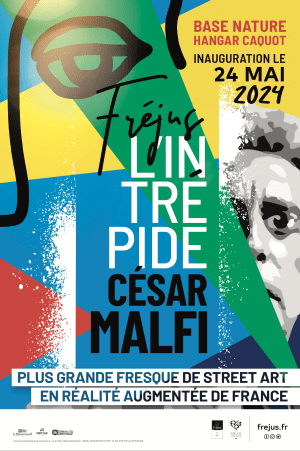Description
The episcopal group in Fréjus is a set of four exceptional monuments.
The cathedral marks the entry of the bishopric in the region in the year 374, gradually changing over the years. The baptistery, an important witness to the expansion of Christianity, marked many souls with its blessing and the eyes fixed on its marble and granite columns still admire its beauty and its era.
The cloister is an open book that represents the world in the 14th century: its decorated woodwork is unique in France. The Episcopal Palace, now the town hall, proudly displays its medieval façade and secretly preserves the treasures of its past.
.
Contact details
The Episcopal Group
48, rue du Cardinal Fleury
83600 Fréjus
Ticket office
Share
Favourite
- The paintings and marble columns in the cloister
- The altarpiece by Jacques Durandi, great 15th century painter from Nice
- The glazed tile roof of the belfry
- The details of the capitals in the baptistery
Practical info
Opening times
Horaires sous réserve
Dernière admission 30 minutes avant la fermeture
DU 2 JANVIER AU 31 MAI
Ouvert tous les jours sauf le lundi10.00-13.00 / 14.00-17.00
DU 1ER JUIN AU 30 SEPTEMBRE
Ouvert tous les jours10.00-12.30 / 13.45-18.30
DU 1ER OCTOBRE AU 31 DÉCEMBRE
Ouvert tous les jours sauf le lundi10.00-13.00 / 14.00-17.00
Prices
Full price: €6
Reduced rate: €5
Groups (based on 20 people): €5
School groups: €20
Free
Under 18 years old (in a family and not school groups)
18-25 years old (European Union nationals and non-European legal residents in the territory of the European Union)
People with disability and a companion
Jobseekers, on presentation of a certificate of dated no more than 6 months before
Culture card – ICOM card
Découverte du groupe épiscopal
SAINT-LÉONCE CATHEDRAL
The cathedral, dominating the landscape of the old town, is one of the many monuments in Fréjus on the list of Historical Monuments since 1862.
The first cathedral under the name of the Virgin and Saint-Léonce (Bishop of Fréjus 400? – 433), traces of which can be seen in the large medieval nave may have been built on the site of an ancient temple or under the Roman basilica in the 5th century AD.
During the early Middle Ages, in the 11th century, another church was added to the north, lying against the previous one. This second church was parallel and contiguous to the first but also smaller. Extended in the 12th century, it then became the parish church, today nave Saint-Etienne.
At that time the parish cemetery adjoined the north of the church: it was one of the earliest examples of a cemetery in a town in southern Gaul.
It is described as a “double church”, quite usual for such monuments throughout Christendom.
The beginning of the 13th century saw an important monumental addition. The Notre-Dame nave was completely rebuilt. To the west piles were raised to support the bell tower in the axis of the nave. To the east, the nave’s footprint was extended by an apse, in a semi-dome, surmounted by an open-gorged tower, similar to that of the urban enclosure, giving the building a fortified aspect, and thus rare character throughout Mediterranean architecture. This somewhat military aspect is the expression of the military and temporal power exercised by the clergy.
The bell tower, restored after the Second World War, actually dates from the 13th century for its lower part and the 16th century for the octagonal drum and the arrow in glazed Provence “malons” or tiles. The green and ochre colours of the malons in the light gives the bell tower sumptuous golden reflections.
In 1530, the new entrance to the cathedral, with beautiful carved wooden doors, led to the removal of the old entrance which opened onto the cloister.
It made space for the sepulchres of two bishops, Bishop Barthélemy and Bishop Pierre de Camelin, a layout that has two statues ordered from a Genoese workshop. In the Saint-Etienne nave is the Baroque high altar attributed to Dominique Fossati, 18th century marble sculptor from Marseille.
Inside a type of cross rib vaulted “Lombard” structure, which came straight from Lombardy, (Italy) covers the nave. In addition, the stalls in walnut in the apse, date from 1441. They are attributed to the sculptor Toulon Jean Flamenc.
The current organ case was made in 1991 by Pascal Quoirin in Saint-Didier, Vaucluse, and was inspired by Italian 17th and 18th century organs.
The sacristy that already existed there in the 12th century, is covered with Louis XV style (18th century) walnut woodwork. The slate lintel over the door is carved with the arms of Provost Georges Fenilis.
Finally, the Saint Marguerite altarpiece is a religious painting from the late Middle Ages, supported by an assembly of wood panels. Painted in tempera, the pictorial technique consists of grinding the colours with water and then diluting them (or soaking them) with lukewarm glue or gum.
Of international Gothic style, the Saint Marguerite altarpiece (1454) is the work of Jacques Durandi (around 1410 – 1469), precursor to Louis Brea, Master of the primitive school of Nice. The Fréjus altarpiece, bearing the name of the person that commissioned it (Antoine Boneti) and the painter, is the only work that can be attributed with any certainty to Jacques Durandi.
THE BAPTISTERY
Baptistery: baptisterium in Latin – “basin for cold baths”
The Paleochristian Baptistery of Fréjus – (listed as a Historical Monument in 1908) was built at the end of the 4th or the beginning of the 5th century. The state of conservation of this baptistery is remarkable. Up to the level of the high windows, the structure is original. The walls are red sandstone and green sandstone from the Esterel Massif, and brick, mainly decorative.
In the year 374 during the Council of Valencia a bishop was appointed for Fréjus, which proves that an important religious community existed there, thus making Fréjus the oldest bishopric in the Var and the second oldest in France after Lyon.
Baptism is a rite of passage, which explains why the baptistery is almost always a separate monument. Often octagonal, like that in Fréjus or the Baptistery of Lateran in Rome, is the first construction expressly dedicated to this function. It represents the seven days of the week (and the creation of the world) plus the day of resurrection and eternal life (mystical arithmology of the resurrection which baptism symbolizes).
In the 4th century Catholics did not yet baptize new-borns. Indeed at that time only adults received the sacrament of baptism, in order to erase all their sins, at Easter. Only able to be forgiven once, believers waited a long time before being baptized, as was the case of Emperor Constantine (who granted freedom of worship by the Edict of Milan in 313).
It wasn’t until the Middle Ages that infant baptism became the custom.
The ceremony, is the ritual that we know today, immersion, a symbolic gesture representing the absolution of sins and the birth of a new child of God.
The baptistery is adorned with granite columns that have been re-used and date from antiquity. Five of these columns come from the Massif du Gigri Dag, near the Turkish city of Ezine, (Troite granite). It is a particular granite with very beautiful dark spots, rich in black mica. Each column supports a capital of marble from Carrara or Asia Minor, (Proconnese, the present-day Island of Marmara), six of them re-used Roman columns from the third and fourth century, only two having been carved in the fifth century.
The wide main entrance of the baptistery dates from the 16th century, certainly during the construction of the new entrance porch of the Episcopal Group in 1530. The current door and gate date from the 18th century, thanks to the Bishop de Fleury, who was bishop of Fréjus from 1698 to 1715.
Its cupola was restored (1922 – 1931), by Jules-Camille Formigé, chief architect of the Historical Monuments, in charge of Provence from 1920.
THE CLOISTER OF FRÉJUS
The canons supported and assisted the bishop. With a provost at their head, they formed the Chapter. The first mention of a chapter in Fréjus dates from 1038. Until the beginning of the 12th century, the chapter of Fréjus, made up of 12 canons and led by a provost was under the close tutelage of the bishop with whom it shared both income and housing. Following disagreements, the assets of the two partners were separated. It was after this that the canons chose to settle north of the cathedral and at that time the cloisters galleries were laid out. It served as the Cathedral’s forecourt. In the eastern wall of the gallery is a trace of the medieval gate to the Cathedral; it is now walled up together with the oculus that surmounts it.
On the ground floor double marble columns receive the ends of the pointed arches. Carrara marble columns, carved in the former podium of the amphitheatre, or marble columns from Genoa, a city that had major trading relations with Fréjus. These capitals present a simplified version of the classic Corinthian capital. To the south, a chapter house set up above the vestibule of the Cathedral welcomed the canons during their deliberations.
A stone vault was planned to cover the galleries. Some traces of the footings are still visible. Certainly too heavy, it was replaced in the middle of the 14th century (1350) by a larch wood frame, much appreciated for its plasticity and reputed resistance to rot, from the forest of Boscodon in the Hautes-Alpes. Each of the caissons in this framework had a painted decoration. The presence of the fleur de lys on one of the caissons, cannot be earlier than 1246, when Charles 1st of Anjou, brother of Saint-Louis, became Count of Provence. 1200 caissons in the 4 galleries of the cloister were painted. Currently 400 are still visible. The themes are varied: hybrid beings, monsters, saints, busts, scenes of everyday life, clergymen and more. It is an exceptional example of 14th century painted decor, unique in a cloister in France.
The Provost’s house was east of the cloister on the 1st floor. This western facade shows a wall with embossing similar to that of the bell tower and the Cathedral apse. In the centre, a pointed arch door is sheltered by a murder hole, a kind of opening from which stones could be thrown at the approaching enemy.
The floor, very damaged suffered greatly during the French Revolution. Sold as national property, the cloister was then completely parasitized by new constructions and then was listed as a Historical Monuments in 1875. It is then that the cloister and the old well, which opens on to an old Roman cistern, and the double staircase going upstairs, were restored by Jules-Camille Formigé, chief architect of the Historical Monuments between 1922 and 1931,.
Restoration of the roof on the east, west and south galleries gradually became essential to restore the monument’s volume, but even more so to ensure the conservation of the painted decor of the wooden ceiling. This work was done in 2008 in line with the projects setup by the architect Francesco Flavigny.
THE EPISCOPAL PALACE
The first bishop’s residence was built to the south of the Cathedral in the 5th century. This episcopal residence was altered in the 11th and 12th century, which required a chapter of 12 canons near the bishop. The bishop remained alone after the separation from the canons and his residence became a real castle.
Jacques Duèze (bishop from 1300 to 1329), future Pope John XXII, turned the castle into a palace. The construction of the Episcopal Chapel dedicated to St. Andrew (first mention in 1303) dates from this time. It was restored in 1856 during the episcopate of Bishop Jordany (from 1855 to 1876) who left mark with his coat of arms on the mosaic floor. The vault simulates a sky sown with gold stars and is reminiscent of the ceiling of Sainte Chapelle in Paris. It was listed as an historic monument in 1908.
The palace was abandoned by Bishop de Fleury (from 1699 to 1715), famous for also being tutor and minister to Louis XV.
From the archives of this era which are very damaged, we arrived an inventory on the death of Bishop de Castellane (from 1715 to 1739), which dates from 1738 – 1740, which gives us a very specific description.
On the ground floor: service function, carriage shed, food warehouse, bakery, servants’ rooms, laundry, prison (the bishop had a court), stables and storage rooms.
The 1st floor meanwhile held the service rooms, kitchen and pantries, the bread room, the servants’ hall, and on the front: the reception rooms and dining room, sitting room and bedrooms for the bishop’s guests, his court and his secretary, latrines, access for the bishop to the cathedral (still visible in the last span.
On the 2nd floor, the bishop’s private rooms were located on the south-west corner as were the bedrooms for his close entourage. The chapel is still visible today, in the south wing, as well as a tower above.
Sold as national property during the revolution, the city of Fréjus bought it and after the restoration (1823) returned it to the church. Bishop de Richery (from 1823 to 1829), opted for radical renovations. Everything was destroyed except for buildings to the east. Only one third of the original palace remains. The architect of the department of Var, Lantoin, produced the plans for the new episcopal palace. After the separation of the church and the state in 1905, the city of Fréjus asked for the property back and the palace officially became the town hall of Fréjus in 1912.
The bishopric of Fréjus – Toulon has been in Toulon since 1958.






